
The Orion Nebula. Image size: 2.9°x2.5°. DSS image. © AAO/ROE
The Orion nebula is one of the brightest nebulae in the sky and can easily be seen with the naked eye. It was discovered by Nicholas Peiresc in 1610 (previously it had only been classified as a star - Theta Orionis). There are many other (fainter) nebulae surrounding the Orion nebula and there are many stars forming in this region. The Orion nebula is probably the most actively studied of all the nebulae in the sky.

There are a lot of nebulae in the Orion region. This is a list of all of the principal nebulae, although most of these are only the brightest parts of extensive nebulous regions which can be found throughout the constellation of Orion. All of the nebulae in this table have been given the same standard distance of 1300 light years, in reality they are probably scattered over several hundred light years.
1 2 3 4 5 6 7 8
Catalogue Equatorial Galactic Size Type Distance Size Other Names
Number Coordinates Coordinates (arcmins) (ly) (ly)
RA (2000) Dec l° b°
------------------------------------------------------------------------------------------
IC 2118 05 04.5 -07 16 207.1 -27.1 180' R 1300 70 Witchhead nebula
NGC 1788 05 06.9 -03 21 203.5 -24.7 8' R 1300 3
Sharpless 278 05 19.8 -05 40 207.4 -22.9 50' ? 1300 20
IC 420 05 32.2 -04 30 207.8 -19.7 6' E 1300 2
IC 423 05 33.4 -00 37 204.3 -17.6 6' R 1300 2
IC 424 05 33.6 -00 25 204.2 -17.5 120' R 1300 45
NGC 1973 05 35.0 -04 44 208.4 -19.1 5' RE 1300 2
Sharpless 264 05 35.2 +09 56 195.0 -12.0 60' E 1300 25 Lambda Orionis
NGC 1975 05 35.2 -04 41 208.3 -19.1 10' RE 1300 4
NGC 1976 05 35.3 -05 23 209.0 -19.4 66' RE 1300 25 M42, Orion Nebula
NGC 1977 05 35.4 -04 50 208.5 -19.1 42' RE 1300 15
NGC 1980 05 35.4 -05 54 209.5 -19.6 14' E 1300 5
NGC 1982 05 35.5 -05 16 208.9 -19.3 20' RE 1300 8 M43
NGC 1990 05 36.2 -01 12 205.2 -17.3 50' R 1300 20 Epsilon Orionis
IC 427 05 36.3 -06 37 210.3 -19.7 ? RE 1300 ?
IC 428 05 36.4 -06 27 210.2 -19.6 ? RE 1300 ?
NGC 1999 05 36.5 -06 43 210.4 -19.7 16' R 1300 6
IC 426 05 36.5 -00 17 204.4 -16.7 5' R 1300 2
IC 430 05 38.5 -07 05 211.0 -19.4 11' R 1300 4 IC 429
IC 431 05 40.3 -01 28 206.0 -16.5 5' R 1300 2
IC 432 05 41.0 -01 30 206.1 -16.3 8' R 1300 3
IC 434 05 41.0 -02 25 206.9 -16.7 60' E 1300 25 Horsehead Nebula
NGC 2023 05 41.6 -02 14 206.8 -16.5 10' R 1300 4
NGC 2024 05 41.9 -01 51 206.5 -16.3 31' RE 1300 12 Flame Nebula
IC 435 05 42.9 -02 19 207.1 -16.3 5' R 1300 2
Sharpless 276 05 45.2 +02 03 203.4 -13.7 840' E 1300 320 Barnard's Loop
NGC 2064 05 46.3 -00 01 205.4 -14.5 12' R 1300 5
NGC 2067 05 46.5 +00 06 205.3 -14.4 8' R 1300 3
NGC 2068 05 46.7 +00 03 205.4 -14.3 8' R 1300 3 M78
NGC 2071 05 47.1 +00 18 205.2 -14.1 5' R 1300 2
|
Column 1: The standard catalogue name for the nebula. Column 2: Right Ascension and Declination for epoch 2000. Column 3: Galactic Longitude (l) and Latitude (b). Column 4: Angular size of the nebula in arcminutes. Column 5: Nebula type: E = emission, R = reflection. Column 6: Approximate distance to the nebula. Column 7: Approximate size of the nebula in light years. Column 8: Alternative name of the nebula.
There are eight star clusters associated with the nebulae in the Orion region. This includes the 'Trapezium cluster' which is primarily responsible for illuminating the Orion nebula, M42. One of the clusters in this list - NGC 2232 - is about 300 light years from the Orion nebulae but it may also have formed in this region, it is certainly old enough to have drifted this distance from the Orion nebula.
1 2 3 4 5 6 7
Catalogue Equatorial Galactic Size Distance Age Other Names
Name Coordinates Coordinates (arcmins) (ly) (million
RA (2000) Dec l° b° years)
-------------------------------------------------------------------------------------------
Collinder 69 05 35.2 +09 56 195.0 -12.0 70' 1400 11 Lambda Orionis cluster
NGC 1981 05 35.2 -04 26 208.1 -19.0 28' 1300 ?
NGC 1976 05 35.3 -05 23 209.0 -19.4 47' 1300 13 Trapezium cluster
NGC 1977 05 35.3 -04 49 208.5 -19.1 20' 1300 ?
Collinder 70 05 35.5 -01 06 205.0 -17.3 140' 1300 10 Orion's Belt cluster
NGC 1980 05 35.5 -05 55 209.5 -19.6 20' 1300 ?
Lund 1158 05 38.8 -02 36 206.8 -17.3 10' 1200 ? Sigma Orionis cluster
NGC 2232 06 28.1 -04 51 214.6 -7.4 45' 1200 53
|
Column 1: The standard catalogue name for the cluster.
Column 2: Right Ascension and Declination for epoch 2000.
Column 3: Galactic Longitude (l) and Latitude (b).
Column 4: Angular size of the cluster in arcminutes.
Column 5: Distance to the cluster.
Column 6: Approximate age of the cluster in millions of years.
Column 7: Alternative name of the cluster.
References: Dias W, Alessi B, Moitinho A, Lépine J, (2002). New catalogue of optically
visible open clusters and candidates. Astron and Astrophys, 389, 871.
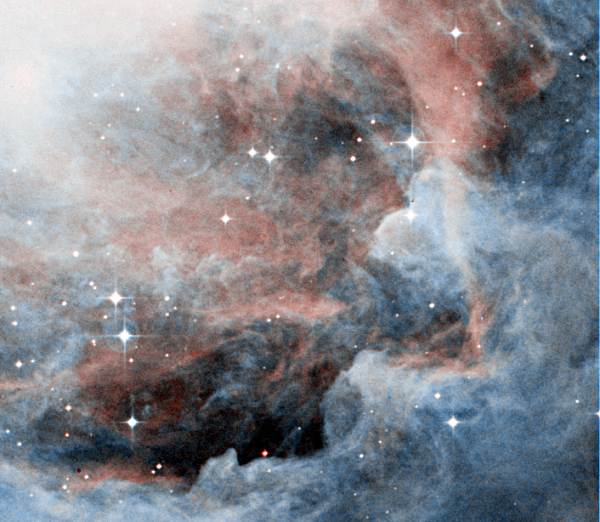
Above - a closeup view of a small part of the Orion nebula (centred on RA=05h34m10s, Dec=-05°40'). This image is about 7.5 light years across. Our entire solar system could fit into this area about 20 million times.
This map of bright nebulae in the constellation of Orion shows how the Orion Nebula (M42) is only a small part of a large collection of bright nebulae. The most important nebulae are labelled. The IC 434 region above the Orion nebula is another region of star formation and contains the famous 'Horsehead' dark nebula. M78 is a small nebula but famous for being one of the brightest 'reflection nebulae' in the sky. Barnard's Loop is a huge semicircular nebula that almost surrounds the entire constellation - this nebula is very faint though and it is only easily detected on long-exposure photographs. The Lambda Orionis nebula at the top of the constellation is a faint nebula associated with a star cluster. Finally, the IC 2118 nebula is a faint reflection nebula which is probably illuminated by the star Rigel (Beta Orionis). IC 2118 is sometimes called the 'Witch-head nebula' because on photographs it looks like the profile of a witch's head!
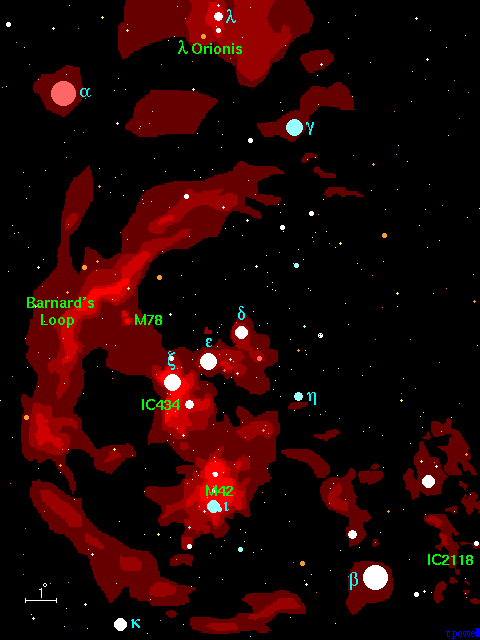
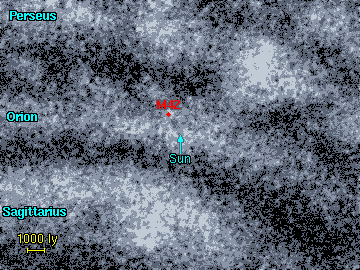
|
The distance to the Orion nebula is accurately known especially because there are many bright star clusters in this region. The nebula is about 1300 light years away. It is because the constellation of Orion is rich in nebulae and bright stars that the local arm of the Galaxy was called the Orion Arm. |
| Right - a map of the Orion region made with a radio telescope. This map (of carbon monoxide emission) shows where the molecular clouds in Orion are densest, and how they are found across the entire left side of the constellation. It is clear that the M42 region and the IC 434 region are the densest parts of the nebulae here. |
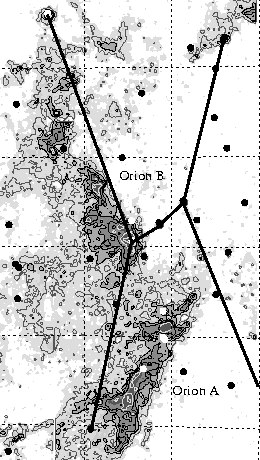
|
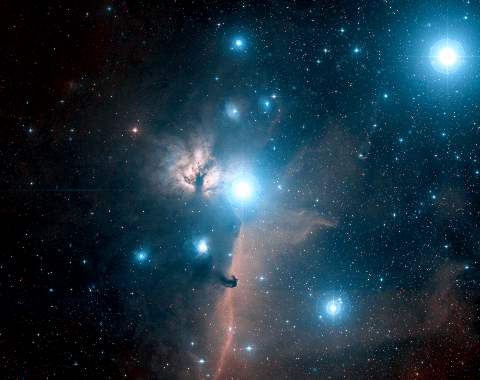 IC 434. Image size: 2.7°x2.1°. DSS image. © CalTech/Palomar |
Left - the IC 434 region which surrounds the bright star Zeta Orionis. The IC 434 nebula is the red emission nebula which extends downwards from the star. The dark horsehead nebula can be seen intruding into the nebula. To the left of Zeta Orionis is NGC 2024, also known as the 'Flame Nebula' because it resembles a candle flame. |
| Right - the bright reflection nebula M78. This nebula was discovered by Pierre Méchain in 1780. The blue colour of this nebula is typical of a reflection nebula - the gas and dust in the nebula do not emit any light, instead it is merely reflecting light from stars within the nebula. M78 is only the brightest nebula in this picture, above it is NGC 2071, and the region to the right of M78 is NGC 2064 and NGC 2067. | 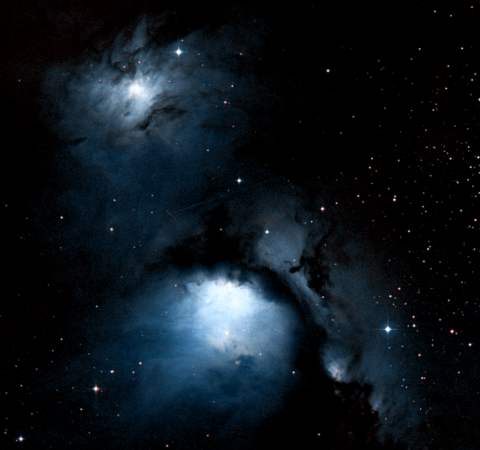 M78. Image size: 0.50°x0.46°. DSS image. © CalTech/Palomar |